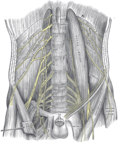Lumbar nerves
Lumbar nerves are the five pairs of spinal nerves emerging from the lumbar vertebrae in the lower back. They are numbered L1 to L5, going from top to bottom. These nerves are part of the peripheral nervous system and are responsible for transmitting signals between the central nervous system and the lower body.
Anatomy
The lumbar nerves originate from the spinal cord in the lumbar region of the spine. Each nerve emerges from the spinal cord through a gap between two vertebrae, known as the intervertebral foramen. The nerves then branch out to supply different parts of the lower body.
L1
The L1 nerve, also known as the first lumbar nerve, supplies the skin and muscles of the lower back and upper part of the hip.
L2
The L2 nerve, or second lumbar nerve, supplies the skin and muscles of the upper thigh and lower part of the hip.
L3
The L3 nerve, or third lumbar nerve, supplies the skin and muscles of the middle part of the thigh.
L4
The L4 nerve, or fourth lumbar nerve, supplies the skin and muscles of the lower thigh, knee, and upper part of the calf.
L5
The L5 nerve, or fifth lumbar nerve, supplies the skin and muscles of the lower leg and foot.
Function
The lumbar nerves play a crucial role in transmitting signals between the brain and the lower body. They carry sensory information from the skin, muscles, and joints of the lower body to the brain, and motor commands from the brain to the muscles of the lower body.
Clinical significance
Damage or compression of the lumbar nerves can lead to a range of symptoms, including pain, numbness, and weakness in the lower body. This can be caused by a variety of conditions, such as lumbar disc disease, spinal stenosis, and lumbar radiculopathy.
See also
Transform your life with W8MD's budget GLP-1 injections from $125.
W8MD offers a medical weight loss program to lose weight in Philadelphia. Our physician-supervised medical weight loss provides:
- Most insurances accepted or discounted self-pay rates. We will obtain insurance prior authorizations if needed.
- Generic GLP1 weight loss injections from $125 for the starting dose.
- Also offer prescription weight loss medications including Phentermine, Qsymia, Diethylpropion, Contrave etc.
NYC weight loss doctor appointments
Start your NYC weight loss journey today at our NYC medical weight loss and Philadelphia medical weight loss clinics.
- Call 718-946-5500 to lose weight in NYC or for medical weight loss in Philadelphia 215-676-2334.
- Tags:NYC medical weight loss, Philadelphia lose weight Zepbound NYC, Budget GLP1 weight loss injections, Wegovy Philadelphia, Wegovy NYC, Philadelphia medical weight loss, Brookly weight loss and Wegovy NYC
|
WikiMD's Wellness Encyclopedia |
| Let Food Be Thy Medicine Medicine Thy Food - Hippocrates |
Medical Disclaimer: WikiMD is not a substitute for professional medical advice. The information on WikiMD is provided as an information resource only, may be incorrect, outdated or misleading, and is not to be used or relied on for any diagnostic or treatment purposes. Please consult your health care provider before making any healthcare decisions or for guidance about a specific medical condition. WikiMD expressly disclaims responsibility, and shall have no liability, for any damages, loss, injury, or liability whatsoever suffered as a result of your reliance on the information contained in this site. By visiting this site you agree to the foregoing terms and conditions, which may from time to time be changed or supplemented by WikiMD. If you do not agree to the foregoing terms and conditions, you should not enter or use this site. See full disclaimer.
Credits:Most images are courtesy of Wikimedia commons, and templates, categories Wikipedia, licensed under CC BY SA or similar.
Translate this page: - East Asian
中文,
日本,
한국어,
South Asian
हिन्दी,
தமிழ்,
తెలుగు,
Urdu,
ಕನ್ನಡ,
Southeast Asian
Indonesian,
Vietnamese,
Thai,
မြန်မာဘာသာ,
বাংলা
European
español,
Deutsch,
français,
Greek,
português do Brasil,
polski,
română,
русский,
Nederlands,
norsk,
svenska,
suomi,
Italian
Middle Eastern & African
عربى,
Turkish,
Persian,
Hebrew,
Afrikaans,
isiZulu,
Kiswahili,
Other
Bulgarian,
Hungarian,
Czech,
Swedish,
മലയാളം,
मराठी,
ਪੰਜਾਬੀ,
ગુજરાતી,
Portuguese,
Ukrainian
Contributors: Prab R. Tumpati, MD







